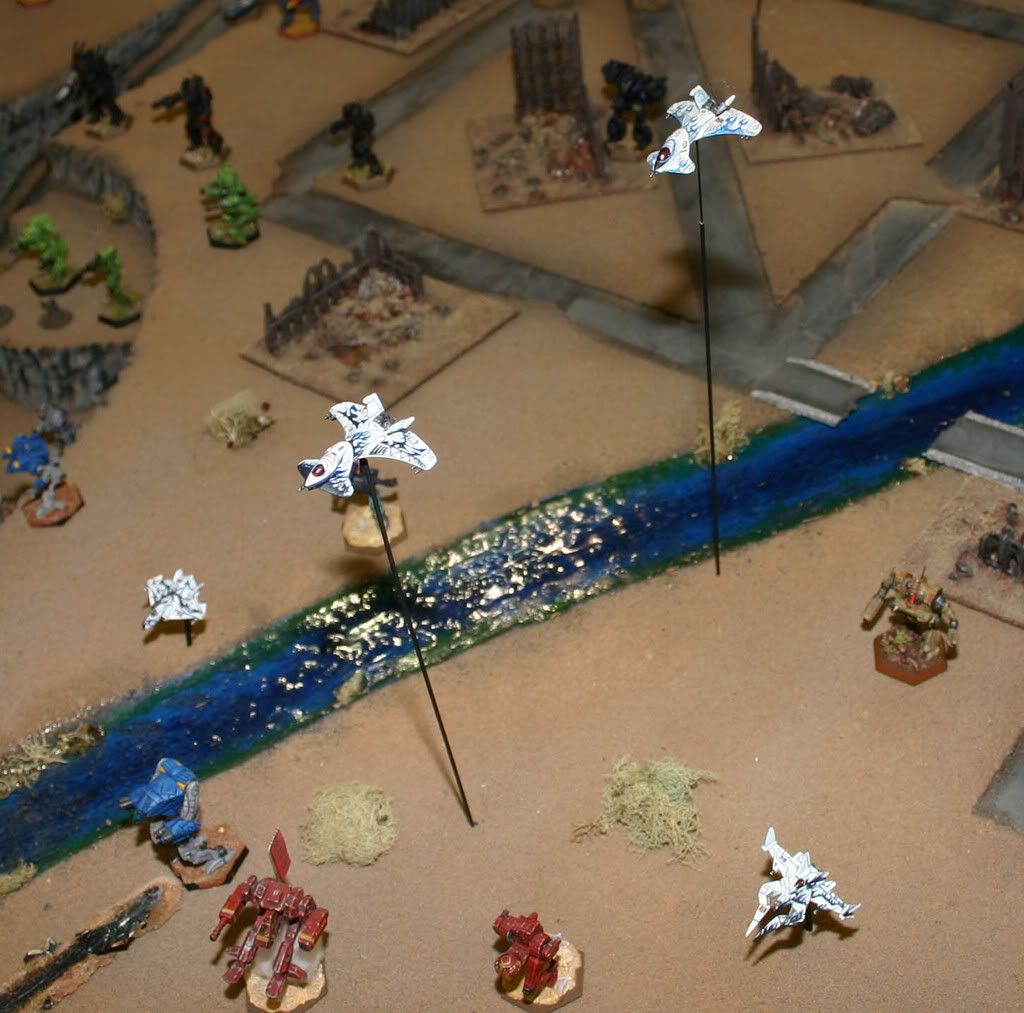
[Camospecs diorama table at GENCON 2007, photo by me]
The map: Aerotech units move so fast relative the the standard CBT scale it's hard to get away from having separate maps. My though here is to place markers 16 hexes apart on the CBT map to indicate the center of the corresponding Aerotech map hexes (henceforth AeroHex markers). All Aerotech movement is done by Aerotech rules, with some adjustments to accomodate the CBT map. Aerotech units are considered to be approximately at the location of the markers, but are placed in a specific CBT map hex for the purposes of attacks.
Initiative:
1) All Aerotech units spend half of their movement first, with the side losing initiative making all it's moves first. Aero units moving through CBT map hexes may declare an attack on that hex.
2) Standard initiative then proceeds with Aero units as part of the sequence. Any Aerotech unit ending it's movement or declaring an attack within a hex should have it's miniature placed within 8 hexes of that AeroHex marker on the map. The controlling player may choose any hex, but facing must correspond to it's facing at the point when the attack was declared (exception, diving units may face down?, so that ground attacks all strike the front).
Declaration of fire:
Declaration of fire within specific hexes occurs during movement, but declaration against individual units occurs as part of the normal declarations.
Aero units: When Aero units declare targets, the controlling player must declare an "Attack Point" within 8-Piloting hexes of where it was placed at during movement or attack declaration, but no more than 8 hexes away from the AeroHex marker representing the Aerospace hex it is in. The same facing is maintained. For strafing attacks the Attack Point marks the (beginning/middle/end) of the strafing run.
Ground units: Ground units may declare fire against Aero units at any AeroHex marker they have moved through during the turn, or at the Attack Point. Treat the Attack Point as an additional Aerohex marker for the purpose of facing and range to target. The firing unit does not have to declare fire on the closest AeroHex marker.
Modified Facing: For the purpose of firing at Aero units, firing at the closest AeroHex marker to the firing unit, or any other marker on the "approach path", results in an attack on the front facing of the Aero unit. Attacks on the second closest (or further) markers on the "retreat path" are treated as attacks on the side or rear of the Aero unit, depending on the location of the ground unit relative to that marker.
Modified Range: Double the effective short, medium, and long ranges of all weapons for the purpose of air-to-ground and ground-to-air fire. Active ECM is considered to be effective within 8 hexes of any AeroHex marker on the flight path (but not the attack point). Do not double minimum ranges. Do not double the radius of area effect weapons.
The next thing is to reconsider the defensive movement modifiers for very high speeds. In a system using 2d6 the difference between a +4 and +5 modifier is much larger than the difference between a +2 and a +3. I am thinking that Aero units should have a completely different chart for this, and a finer gradation of modifiers. This last bit is a little tricky: I'm saying there need to be something like a +4.5 modifier, and an extra die roll to resolve the "fraction".
Example: If an Aero unit has a defensive modifier of +4.5, then resolve the attack as if this was a +4. If the attacker rolls exactly the target number, then there is a 50% change the attack will still miss, resolved by a d10 roll (roll 5+, with "0" counted as zero, not "10"). This could also be done with a d6 roll, but that requires an odd definition of "fraction" that isn't really important for this discussion. The new Aero movement modifier chart could then have meaningful modifiers that don't make them completely invulnerable on high speed passes.
Another thought might be to adjust air-to-ground modifiers for air movement, so that Aero units might need to slow down a bit to get decent shots on ground units. There is a certain fairness here that I like, because the Aero units can be still be fast and invulnerable if they want, but at the cost of combat ineffectiveness.
Time for me to go review the Aero rules again, and see what sort of alternate move-mod chart might be workable. I can check out the other rules I've forgotten about while I'm at it.

No comments:
Post a Comment